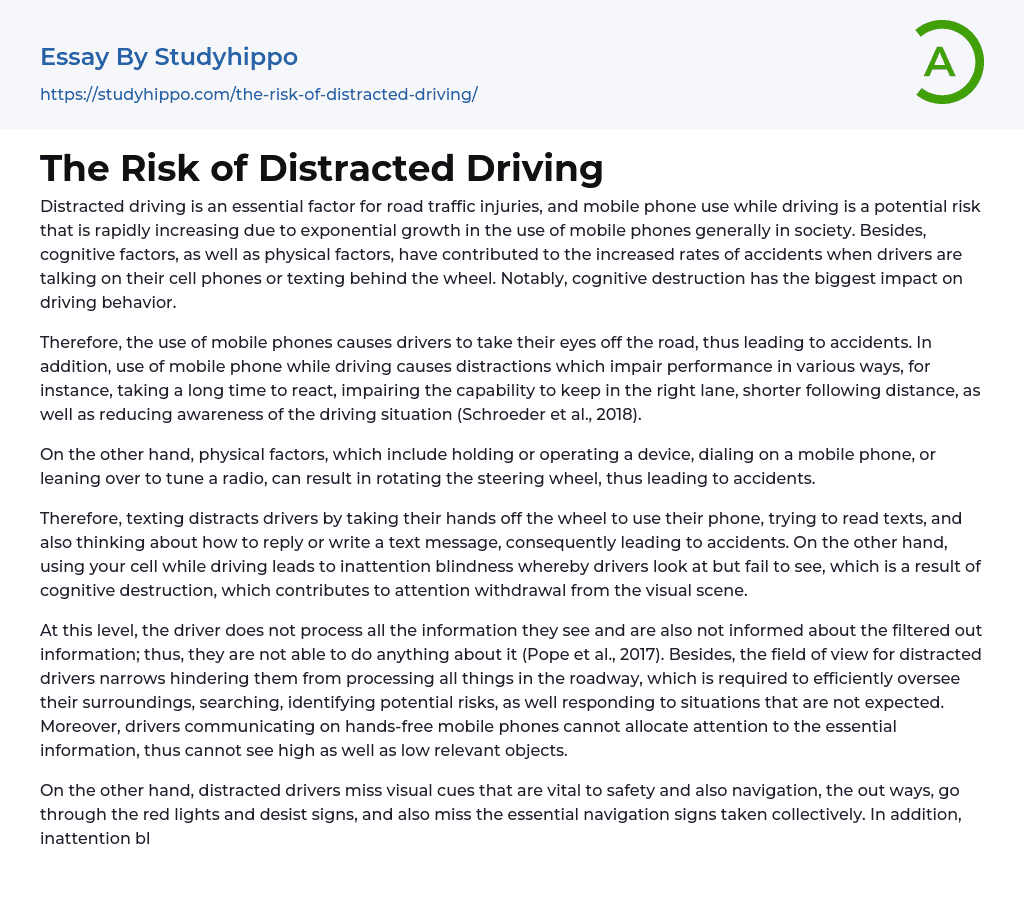Distracted driving is an essential factor for road traffic injuries, and mobile phone use while driving is a potential risk that is rapidly increasing due to exponential growth in the use of mobile phones generally in society. Besides, cognitive factors, as well as physical factors, have contributed to the increased rates of accidents when drivers are talking on their cell phones or texting behind the wheel. Notably, cognitive destruction has the biggest impact on driving behavior.
Therefore, the use of mobile phones causes drivers to take their eyes off the road, thus leading to accidents. In addition, use of mobile phone while driving causes distractions which impair performance in various ways, for instance, taking a long time to react, impairing the capability to keep in the right lane, shorter following distance, as well as reducing awareness o
...f the driving situation (Schroeder et al., 2018).
On the other hand, physical factors, which include holding or operating a device, dialing on a mobile phone, or leaning over to tune a radio, can result in rotating the steering wheel, thus leading to accidents.
Therefore, texting distracts drivers by taking their hands off the wheel to use their phone, trying to read texts, and also thinking about how to reply or write a text message, consequently leading to accidents. On the other hand, using your cell while driving leads to inattention blindness whereby drivers look at but fail to see, which is a result of cognitive destruction, which contributes to attention withdrawal from the visual scene.
At this level, the driver does not process all the information they see and are also not informed about the filtered out information; thus, they are no
able to do anything about it (Pope et al., 2017). Besides, the field of view for distracted drivers narrows hindering them from processing all things in the roadway, which is required to efficiently oversee their surroundings, searching, identifying potential risks, as well responding to situations that are not expected. Moreover, drivers communicating on hands-free mobile phones cannot allocate attention to the essential information, thus cannot see high as well as low relevant objects.
On the other hand, distracted drivers miss visual cues that are vital to safety and also navigation, the out ways, go through the red lights and desist signs, and also miss the essential navigation signs taken collectively. In addition, inattention blindness leads to drivers’ failure to notice what is happening in the driving environment, thus making it impossible to respond safely, for instance, moving the steering or braking to prevent a crash (Huisingh et al., 2019).
Besides, when drivers are using a cell phone, they respond slowly to reactions due to attention switching because the brain must make decisions for every information input, whether to take action on the refined information, how to take action, how to begin the action, as well as how to stop the action. Therefore, these strides take time, and when driving, a fraction of a second is the time between a crash or no crash, life or death.
In addition, drivers on hands-free and hand-held mobile phones also respond slowly in reducing their speed when they are behind a slowing vehicle in front of them; thus, they are most likely to break hard compared to drivers who are not on a mobile phone. Therefore, hands-free phone usage leads to increased
response time to breaking vehicles ahead of drivers, hence resulting in an increment in the rate of crashes.
References
- Huisingh, C., Owsley, C., Levitan, E. B., Irvin, M. R., MacLennan, P., & McGwin, G. (2019). Distracted driving and risk of a crash or near-crash involvement among older drivers using naturalistic driving data with case-crossover study design. The Journals of Gerontology: Series A, 74(4), 550-555.
- Pope, C. N., Bell, T. R., & Stavrinos, D. (2017). Mechanisms behind distracted driving behavior: The role of age and executive function in the engagement of distracted driving. Accident Analysis & Prevention, 98, 123-129.
- Schroeder, P., Wilbur, M., Pena, R., & Abt, S. R. B. I. (2018). National survey on distracted driving attitudes and behaviors-2015 (No. DOT HS 812 461). The United States. National Highway Traffic Safety Administration.
- Animal Cruelty essays
- Charles Manson essays
- Crime Prevention essays
- Crime scene essays
- Criminal Justice essays
- Criminology essays
- Cyber Crime essays
- Damages essays
- Detention essays
- Distracted Driving essays
- Drug Trafficking essays
- Drunk Driving essays
- Forensic Science essays
- Gang essays
- Hate Crime essays
- Homicide essays
- Identity Theft essays
- Juvenile Crime essays
- Juvenile Delinquency essays
- Juvenile Justice System essays
- Law Enforcement essays
- Murder essays
- Organized Crime essays
- Penology essays
- Piracy essays
- Prison essays
- Property Crime essays
- Prostitution essays
- Punishment essays
- Punishments essays
- Rape essays
- Robbery essays
- Serial Killer essays
- Sexual Assault essays
- Sexual Assault on College Campuses essays
- Sexual Harassment essays
- Sexual Offence essays
- Stealing essays
- Surveillance essays
- Ted Bundy essays
- Victim essays
- Violent crime essays
- White Collar Crime essays




